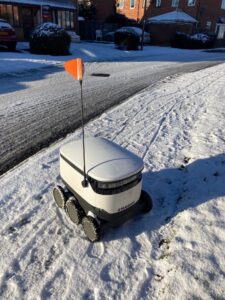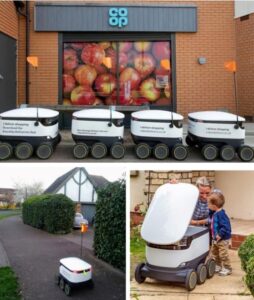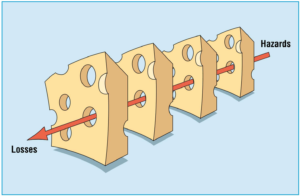 Rapid advances in Artificial Intelligence (AI) are making urban robotics an everyday reality. In this blog post we summarise the story of Starship robots in Milton Keynes (MK) to assess their contribution to the complementary mechanisms and institutions that supported the most vulnerable in MK during a challenging point of the Covid19 pandemic. We then draw on the Swiss Cheese model of complex system hazards and notions of institutional and technical monocultures to investigate how urban robots can make cities better able to cope with unexpected shocks, such as pandemics or extreme weather events.
Rapid advances in Artificial Intelligence (AI) are making urban robotics an everyday reality. In this blog post we summarise the story of Starship robots in Milton Keynes (MK) to assess their contribution to the complementary mechanisms and institutions that supported the most vulnerable in MK during a challenging point of the Covid19 pandemic. We then draw on the Swiss Cheese model of complex system hazards and notions of institutional and technical monocultures to investigate how urban robots can make cities better able to cope with unexpected shocks, such as pandemics or extreme weather events.
Starship robots have become a common sight in the pavements and cycle paths of MK. The robots are suitable for on-demand last-mile deliveries organised around local hubs. Customers place orders through a ‘mobile phone app’ which can be used to track the robot and unlock its cargo compartment once it has reached its destination. In 2018 MK was chosen for a pioneering deployment of autonomous urban robots on account of its low density and its extensive network of segregated roads for pedestrians and cyclists, which are relatively safe and easy to navigate for AI-driven robots such as Starships.

By April 2019, Starship robots completed some 50,000 deliveries in MK and by March 13th 2020 this had increased to 100,000 deliveries. Three days later the United Kingdom unexpectedly entered its first Covid-19 lockdown. The British population was instructed to stay home, all non-essential shops and services were ordered to close and those at the highest risk were advised to follow shielding measures.
MK, like so many other cities across the world, was faced with a major disruption of key aspects of urban life including transport and food provision. The disruption was particularly problematic for housebound and vulnerable individuals (older adults, people with underlying health conditions or those less able to move) as online grocery deliveries were severely affected. Drivers were working extended hours and supermarkets enforced restricted queueing systems but still struggled to cope with the sudden growth in demand as the everyday act of visiting a supermarket was now associated with a high risk of contagion. Consequently, waiting time for deliveries was often measured in weeks.
In contrast, the Starships continued operations in MK during the pandemic with little disruption. Orders doubled overnight and the robots were working non-stop 14 hours a day but remained able to offer same-day deliveries. Although the service had not been designed for that purpose, a robotic fleet which avoided face to face contact was well suited for delivering groceries to those housebound, shielding or self-isolating. Robots could be rapidly transferred from other locations but unlike human drivers they did not need to undergo a lengthy training process – instead, they could be readily connected to servers that functioned as hubs of the AI-driven hive-mind. Thus Starship rapidly expanded its coverage and capacity. The number of robots available for deliveries in Milton Keynes tripled from 30 at the beginning of the pandemic to 100 four months later. Starship robots completed over one million deliveries through the duration of the pandemic, a 900% increase relative to its pre-pandemic level which suggests the robots performed a useful role during the crisis.
However, the benefits provided by Starship were not evenly distributed across MK. Urban robots, like so many other urban technologies, have the potential to reinforce social and spatial inequalities. For instance, the robots were only available in selected areas of MK, covering more affluent areas and neglecting those that were more marginalised. Additionally, many members of vulnerable or marginalised groups, such as those subsisting on a disability allowance, could not afford the delivery fees. Other vulnerable individuals could not use the robots because they were unable to use the mobile phone application, as was the case for less tech-savvy older adults or for the visually impaired. The robots were also unsuitable for some users with physical and mobility impairments. For instance, wheelchair users may find it difficult to reach and unload the robot.
Swiss cheese, monocultures, and coping in an uncertain world
Fortunately, Starship robots were only one of the multiple layers of a system of complementary safety nets. Various initiatives and responses by governmental, commercial and community organisations demonstrated distinct capabilities, strengths and weaknesses and served (or failed to serve) distinct groups at various points through the crisis. Seen this way, the case of the Starship robots in MK seems to be a classic “Swiss cheese” situation. James Reason’s Swiss cheese model (Fig. 2) has become a dominant approach for analysing risk in complex systems ranging from hospitals to airplanes to nuclear reactors. According to this approach, hazards in a complex system are prevented from causing losses by a series of barriers. Each barrier has unintended weaknesses or holes (just like a slice of cheese). When, by chance, all holes are aligned, the barrier fails and harm occurs.

In the case of MK, when the pandemic affected people’s safe access to groceries there were various safety nets with holes in different places. Although the safety net provided by robots was not equally available to everyone in need, it had the distinct advantage of being able to adapt and respond to an unexpected shock in real time. In contrast, safety nets deployed by national and local authorities were far more extensive but slower to adapt when faced with an unprecedented situation. Weeks after the beginning of the lockdown local authorities were still waiting for guidance from national government and did not have access to the full lists of people identified as extremely vulnerable.
Community and volunteer organisations were also surprised by the rapidly changing situation. Some organisations were able to respond in a matter of days but for others it was a matter of weeks before they could adapt to the new situation and provide safe and effective support. Volunteers, being only human, had to find ways to work safely in dangerous situations that robots could take in their stride. On the other hand, volunteer and community organisations benefited from their pre-existing knowledge of vulnerable individuals and were able to support people that robots could not reach. However, they could not easily reach people who had not considered themselves vulnerable before the pandemic. Those same individuals were potentially excluded from government initiatives intended to ensure that vulnerable people could get food, as some individuals who considered themselves vulnerable were not considered as such by government criteria. People with manageable health conditions (e.g., immune deficiencies, asthma) who were able to live independently under ordinary circumstances unexpectedly found themselves vulnerable, housebound and unfamiliar with the support networks that could have helped them but many of them were able to rely on the autonomous robot delivery system.
Two important points emerge when the Swiss cheese metaphor is used to reflect about the case of Starship in MK.
First, more layers are better. The case study does not suggest that robots are the one secret for making cities better able to cope with the unexpected. Rather, it suggests that MK was better able to cope because it had one more tool at hand which in times of crisis became an additional and distinct layer of defence.
Second, Starship robots were useful because the gaps in the metaphorical barriers they provided were in very different places to the holes in other defences. One limitation of the Swiss cheese model is that independence of the barriers is assumed, as well as some randomness in whether the “holes” line up. As the case of Starship demonstrates, it is possible and even likely for several barriers to fail at the same time in the same way. When a critical societal function (e.g., ensuring that groceries can reach households) is structured by a small number of practices, capabilities and technologies (e.g., buyers driving to stores or by couriers from the stores driving to households) there is a risk that when faced with a shock in their environment they will all experience highly correlated and destabilising failures.
Urban robots therefore can make cities better able to cope with the unexpected (such as pandemics and extreme weather events) when they initiate a shift away from technical and institutional monocultures. To achieve that end, it is important that they are not framed as the sole solution to a given urban challenge (potentially becoming a monoculture of their own) but as part of a network of complementary commercial, governmental and volunteer-led approaches for supporting necessary urban functions such as getting groceries to households.
This is a joint blog post reporting on research by Dr Miguel Valdez and Professor Matthew Cook, informed by research undertaken by the Future Urban Environments group and funded by the PVC-RES Coronavirus research fund 2020 (rapid response stream).

Leave a Reply